- Home
- Courtney Milan
Her Every Wish Page 13
Her Every Wish Read online
Page 13
And then, when I was writing, Once Upon a Marquess, a random minor character appeared on the screen and I called him Crash. I don’t know why. It’s not exactly a name one would normally use. But as soon as I wrote the name—Crash—I figured out that his real name was Nigel, and everything sort of followed from there.
The word “bicycle” was in use back in 1866, although rarely; I’ve chosen to use the word “velocipede” almost exclusively because the velocipedes of 1866 were dissimilar from today’s bicycles in a number of ways. For one, there was no bicycle chain in most production models. There were definitely no shocks. And bicycle helmets are an incredibly recent invention. Nonetheless, the bicycle was an amazing invention, and it became all the rage late in the 1860s. Crash would have been perfectly positioned to take over the craze.
Britain was an empire, and for a very long time, one of the chief products that empire sought after was labor. It was involved in the African slave trade for a very long time, until slavery was outlawed in Britain itself in 1772, followed by the abolition of the trade in slaves in 1807, and finally by slavery in British colonies in 1833. This did not end the thirst for cheap labor. In lieu of African slaves, Britain would impress sailors (both domestically and internationally). It was one of the global players engaged in what was colloquially known as the “pig trade”—which involved Chinese laborers who were indentured servants, where some of them entered their period of servitude more involuntarily than others. And of course, Britain ruled over numerous colonies where cheap, abundant, exploitable labor was used—India being one of them.
These workers were often impressed into doing grunt work for the merchant marines. As you can imagine, worker safety was not highly valued, and workers who were injured on the job back in those days had little by way of regulatory protection. The global empire of Britain is littered with stories of sailors from around the world being marooned in various ports. If they weren’t able to work to the rigorous standards of an ocean-going vessel, they might find themselves far from home with no way to return.
Britain didn’t obtain racial data in its census for quite some time, and so reconstructing questions like how many people of color were in Britain in the latter half of the nineteenth century is difficult. But how many is not relevant to the question of their general existence: They were absolutely there, and it’s probably reasonable to assume that those who ended up in London for one reason or another tended to band together.
When I was doing research for Talk Sweetly to Me, I read an essay about how a photographer in the 1920s who was taking pictures of working-class people discovered a tiny neighborhood in Bristol near where the slave ships had docked over a century before. In this area, nearly everyone was some shade of brown, the result of people who had been stranded generations ago and had intermarried with each other and the local population and various sailors of every ethnicity who had wandered by.
When I wrote Crash and his aunt and their group of friends, I was imagining that sort of Bristol neighborhood in London. Given the number of people from around the world who ended up stranded in London, such a place would have to exist.
When Crash says that much of England would refer to his aunt and his friends as whores, this is not meant to be descriptive as many people would understand that term. One of the main problems that authorities had in the 1860s is that it was difficult to corral the spread of STDs because it was hard to tell who was involved in sex work and who wasn’t. This is in part because upper-class English gentlemen were jerks who thought they could have sex with anyone poor, and in part because prostitution just didn’t work the way they thought it did. There were some people who only earned a living in prostitution, but a huge number of people who might be classified as sex workers back then had a regular job, and then maybe a man or three on the side. Many authorities basically assumed that anyone working jobs that earned little enough money had to be involved in prostitution on the side.
Finally, a note on two items mentioned in the book. The velocipede really did start to become popular at the end of the 1860s, and it has basically never stopped since, despite significant advancements in transportation technology. Crash would have gotten his foot in the door right at the start. Crash is also (basically) right when he says that you’re more stable on a bicycle the faster you go. For the same reason, tops wobble less when you spin them faster. It’s a physical phenomenon known as precession. I didn’t want to go into too much detail, because obviously the faster you go, the more you can hurt yourself, and bicycle helmets were a shockingly recent invention, compared to the history of the bicycle.
Second, there is such a thing as a carbolic smoke ball, and that (like other random things that show up in my book) is a joke between me and ten thousand law students who will all say, “ARGH, CARBOLIC SMOKE BALLS!” There’s a famous case from 1892 involving an advertisement for a carbolic smoke ball.
The basic idea behind a carbolic smoke ball was that the ball contained carbolic acid, which interacted with the air and filtered it. The makers of the ball claimed it would filter out, say, influenza germs. Like about 95% of the purveyors of Victorian-era medical equipment, they were totally wrong. The actual Carbolic Smoke Ball Company featured in the 1892 advertisement didn’t exist in 1866, but upon research, I did find references to early inventions that were basically carbolic smoke balls that were period. So I hope you enjoy it.
Acknowledgments
Thank you to Lindsey Faber, Rawles Lumumba, Wendy Chan, and Louisa Jordan for reading this novella on short notice.
Thanks to Melissa Jolly for everything she does.
Beyond that, thanks to everyone in my life who keeps me going: my husband, Carey, my dog, Pele, my cat, Silver, and my chickens, Iphigenia and Bob, who have finally started to produce eggs (thank you!). My friends are too numerous to name, but Tessa Dare, Carey Baldwin, Brenna Aubrey, Alisha Rai, Bree Bridges, Rebekah Weatherspoon, Alyssa Cole, and Leigh LaValle have also provided untold emotional support.
Finally, an extremely belated thanks to Apple. Yes, that Apple. It’s not exactly a secret that I’m an Apple fangirl, but I’ve written every book I’ve ever produced on Apple products. I really appreciate it.
2015 and 2016 have also been weird writing years for me. I suspect it looks like my writing has slowed down from prior years. The truth is that I’ve actually been writing a lot of things concurrently.
So finally, to all of you… Thank you for reading. Thank you for your patience. I hope it will be rewarded…soonish, and that you’ll think that it has been worth the wait.
This is a work of fiction. Names, characters, places, and incidents are the product of the author’s imagination or are used fictitiously. Any resemblance to actual events, locales, or persons, living or dead, is purely coincidental.
* * *
Her Every Wish: © 2016 by Courtney Milan.
Cover design © Courtney Milan.
Cover photographs © Grekov’s | shutterstock.com.
Digital Edition 1.0
All rights reserved. Where such permission is sufficient, the author grants the right to strip any DRM which may be applied to this work.

 Her Every Wish
Her Every Wish Midnight Scandals
Midnight Scandals After the Wedding
After the Wedding The Heiress Effect
The Heiress Effect Unraveled
Unraveled The Suffragette Scandal
The Suffragette Scandal The Year of the Crocodile
The Year of the Crocodile The Duchess War
The Duchess War What Happened at Midnight
What Happened at Midnight The Countess Conspiracy
The Countess Conspiracy Proof by Seduction
Proof by Seduction Unlocked
Unlocked Trial by Desire
Trial by Desire The Governess Affair
The Governess Affair Unveiled
Unveiled The Lady Always Wins
The Lady Always Wins Trade Me
Trade Me Unclaimed
Unclaimed This Wicked Gift
This Wicked Gift The Duchess War (The Brothers Sinister)
The Duchess War (The Brothers Sinister) Hamilton's Battalion: A Trio of Romances
Hamilton's Battalion: A Trio of Romances The Turner Series
The Turner Series The Suffragette Scandal (The Brothers Sinister)
The Suffragette Scandal (The Brothers Sinister) Seductive Starts
Seductive Starts The Pursuit Of…
The Pursuit Of… Hamilton's Battalion
Hamilton's Battalion The Carhart Series
The Carhart Series Seven Wicked Nights
Seven Wicked Nights This Wicked Gift (A Carhart Series Novella)
This Wicked Gift (A Carhart Series Novella)